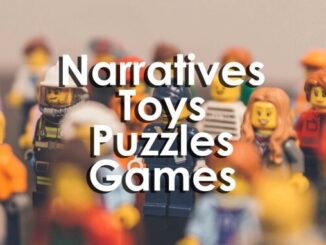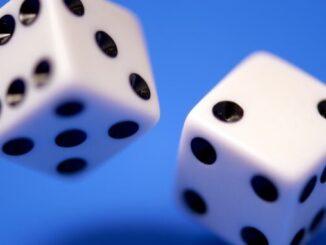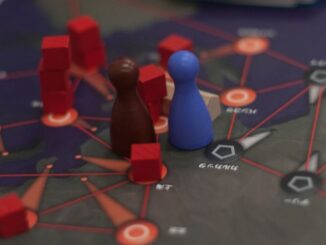
One piece of advice you often come across in pieces about prototyping is to use the highest quality materials you can afford, to make your prototype as realistic as possible and to provide a better experience for those who are playtesting the early versions of your game. There are many prototyping kits you can use – containing ‘blanks’ for often used games components, such as cards, tokens and so on. For example, Erik Agudelo’s TB4C (ToolBox 4 Creativity) offers not only high quality sustainable materials, but also a methodology for using play design as a learning approach – highly recommended.
But alongside those, there is also room for exercising your creativity by creating your own play materials, and expanding your view of what might be acceptable materials to use in ‘paper’ prototypes and playtests before you settle on the final form of your game.
There are two reasons for following the hints and tips below. First, you may be prototyping or playtesting on a tight budget, so the more you can save money on your materials the better. The second, and in my opinion, even more important reason is that making your own toys and game materials allows you the opportunity to play – the very specific form of play / fun which is afforded by Making.
There are well-documented wellbeing benefits of making, which can have effects similar to meditation, increasing levels of dopamine, decreasing anxiety, stress and even depression
As games designers, we often tout the benefits of getting into ‘Flow’, which is at the heart of how people become, and remain, engaged in activities which are just at the right level of challenge. People learn better when in flow, they achieve ‘effortless’ productivity, and it can lead to feelings of joy and happiness. Embracing making into your practice will increase your own experience of flow in your work.
Creative activities, such as making, equip you for improved problem solving. Indeed the making itself, can actually be a problem solving response. As such, making concrete artifacts can have numerous positive benefits on our practice as designers.
What you can use as play materials or the extent to which you embrace making as a practice, and the simplicity of elaborateness of the artifacts you create is really only limited by your imagination, but a suggested toolkit for making might contain the following. You can even carry this with you to playtests/prototyping sessions in case you need to make on the fly.
- Cutting tools – scissors/scapels/craft knives etc
- Sticky stuff – glue/tape/glue stick or even hot glue gun if you are a dedicated crafter
- Mark-making stuff – pens/pencils/markers/paints
- Containers – you can never have enough of these to keep your materials in order. Save shoeboxes/ product boxes etc. Gift boxes of toiletries (Christmas is coming) are great because they are robust and often have clear lids.
Plastic fantastic

Made materials can come in two forms – fixed (those which cannot be unmade or remade once created) and flexible (reusable). For minimum waste and impact use flexible resources early on in your prototyping journey, and only use fixed resources if you have settled on a final(ish) form of an artifact or if the flexible form is to fragile for long term use.
For example, a good selection of Lego bricks is ideal for making and remaking playing pieces. These are especially useful for items such as tokens (pieces which represent a player), and counters (representing points), and as such, a good selection of smaller bricks are recommended. However, you can also build larger components, such as boards, and the Lego Dots range provides potentially limitless possibilities when combined with base boards.
When you are ready to create something more permanent, a good option is using Hama (Perler) beads. These are ‘fixed’ by melting with an iron, and are great for creating anything with an ‘8 bit’ vibe. Although the standard way to use them is to create 2D pictures, with a glue gun you can create 3D objects. They come in three sizes, the most popular ‘midi’, ‘maxi’ – designed for small fingers but great as are, as counters, and ‘mini’ – really tiny, but can produce stunning works of art because of the level of fine detail that can be achieved.
If sculpture and modelling is more your thing, then plasticine provides an excellent ‘flexible’ option, and you can move to Das or Fimo when you want something more permanent. Das gives wonderful effects when textured objects are pressed into it, and works marvellously well with coloured pencils, which can be blended on its surface when dry to make truly beautiful coloured objects.
A word of warning – never mix any kind of modelling clay with Lego. Absolutely NO GOOD will come of that.
Crafting for Games Designers
If you start to view your prototyping and playtesting as an opportunity to extend your experience of different kinds of making, then you open yourself to new experiences, skills, and the joy of working with your hands. Here are some ideas for potential making opportunities.
- Soft crafts such as sewing. While this is not immediately obvious, consider how fabric could be used to make playing surfaces, such as boards and playing mats. Felt is a versatile non-fray material which can be sewed or glued, and stitching is among the most versatile and beautiful methods of decorating surfaces.
- Knitting and crochet – I can’t think of anything more charming to pay with than ‘amigurumi’ player tokens
- Origami – making playing pieces from folded paper is inexpensive, and gives you the option to work with colour and pattern as well as form
- Wooden playing pieces say ‘quality’ to most players, and pyrography is a surprisingly easy and equally surprisingly inexpensive, way of making wooden pieces with pictures and other marks.
- Relief printing with lino cuts or even just the humble potato can make the most beautiful cards and other paper components
Plundering your other games
Not strictly speaking a making activity, but ‘borrowing’ components from your existing game collection is not only inexpensive (free), but often brings inspiration along with practicality. If you doubt this, consider how many games (other than chess) are played on an eight by eight chequerboard, or how many card games feature ‘suits’ (or even how many have 52 cards).
A fun and creative plundering activity which has reaped many benefits for me is to randomly select components from a number of game boxes and to force yourself to include them in some capacity in a game design you are working on. It is surprising how many times this results in a breakthrough design idea.
Nature’s playing pieces

These are especially appropriate to work with when creating games with a natural theme, but many things you can find in nature are so useful as playing pieces that you shouldn’t let your game theme hold you back. Use them as they are, or carry out further joining, cutting, mark making or embellishing to make more appropriate components (and increase your making pleasure). Good stuff to look out for:
Pebbles, seeds, nuts, sticks, leaves, sand, bark (as a surface), feathers, logs, fibres (for joining, tying or even felting in the case of animal fibre), slate (great for boards and play mats)
Recycling and upcycling
There is nothing, literally nothing (OK maybe food waste – and other icky stuff) that cannot be upcycled or recycled to serve as a game component. I have already mentioned boxes, but the very act of looking at every piece of ‘rubbish’ that passes through your hands, as if it were already useful, increases your creativity. Here are a few ideas:
- Plastic milk cartons – can be cut into shapes and coloured with marker pens to serve as ‘standees’. The plastic tops make great standee bases, when you make a slit in them, or can just act as counters, as they are.
- Bottles and jars – obviously great containers – but I have used these as scoring mechanisms – the level they are filled to representing the score – (better filled with sand than water – for obvious reasons)
- Plastic bottles – use as playing pieces for ‘giant’ outdoor games (imagine something like the giant outdoor chess sets)
- Card and paper – I’m sure you can work out how this could be used, but for general day-to-day ‘scrap’ – receipts and so on
- A box full of old DVD-Rs were once made into circular playmats with Sharpie decoration and writing – and these are, as far as I know, still in use, six years later.
Edibles

When I played my first Legacy game, I have to admit to a certain amount of resistance to the idea of destroying and/or defacing game pieces. I really liked the idea that the game world would irrevocably change. In fact, I was really excited about the possibility of the legacy format for learning games around areas such as Climate Change and Ecosystem Degradation. However, I still couldn’t feel comfortable with the idea of spoiling the perfection of a beautiful designed and made game – and let’s face it, games are not cheap items.
A couple of years ago, I came across a book which might have made the legacy format a little more palatable (pun intended) The Edible Games Cookbook by Jenn Sandercock contains a ‘bakers dozen’ of games which you first have to bake or cook, and which you will eventually eat as part of the gameplay.
From cake boards, through sweets used as tokens, to secret codes baked into treats, the potential for creating edible game components is pretty much limitless.
I hope you have enjoyed this brief exploration of the possibilities for bringing making into your games design practice. There are many more ideas which I haven’t even touched on here, and that is the point. Games Design requires creativity and making kills two (and potentially many more) birds with one stone. Not only does it provide us with the concrete components we need for prototyping and playtesting, but it makes us more creative with each project we attempt – benefitting our work and bringing us joy and flow along the way.
- James Bore – The Ransomeware Game - 13th February 2024
- Ipsodeckso – Risky Business - 23rd January 2024
- Review – Luma World Games - 15th December 2023





Be the first to comment